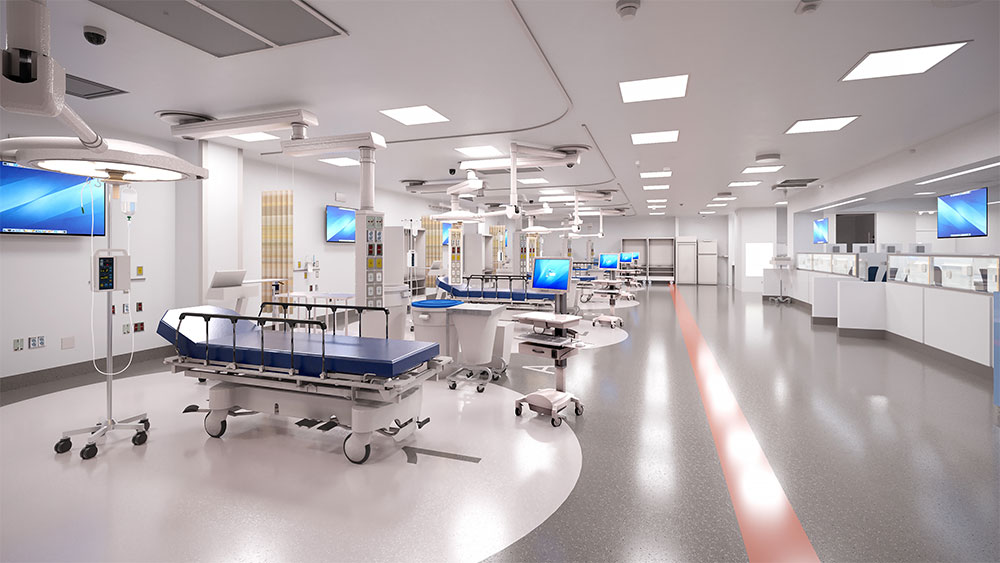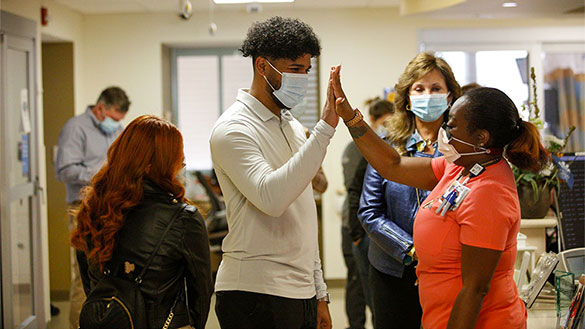The need for a new emergency department

The need for a new emergency department
According to the Centers for Disease Control and Prevention (CDC), nearly 136 million people visit emergency rooms in the United States per year—a national average of 42 out of every 100 people. From strokes and heart attacks to life-threatening injuries and psychiatric crises, hospital emergency rooms across the country are responsible for caring for the nation’s patients when something is suddenly wrong.
Over the past twenty years, our health care providers in Strong Memorial Hospital’s Emergency Department (ED) have seen a substantial increase in emergency visits. The treatment space was originally built to accommodate 66,000 ED visits each year. The ED team now manages more than 110,000 patient visits annually. This continues to be a challenge not only for our patients and families, but also for the teams delivering their care.
This constrained space continues to be a challenge for the teams working to provide outstanding care for patients and families. To accommodate more than 130,000 visits each year, the new ED will nearly quadruple its footprint. This expansion will create distinct areas for adult and pediatric care and will include treatment spaces specialized by types of emergencies, including non-urgent care, substance use emergencies, and for patients exposed to radiation, harmful chemicals, or infectious diseases. The new facility will allow URMC to accept more referrals for specialized care from other hospitals and physicians in the upstate NY region.

The Kessler Trauma Center will serve patients with life-threatening injuries. From these areas, patients may be transported to the operating room, a nearby imaging area, or an inpatient unit for admission.
The Kessler Trauma Center will serve patients with life-threatening injuries such as falls, burns, motor vehicle accidents, gunshot wounds, and other acute issues. As the region’s only Level 1 trauma center and ranked in the top 10% of trauma centers nationwide by the American College of Surgeons Trauma Quality Improvement Program, the Kessler Trauma Center is capable of providing total injury care for patients from prevention through rehabilitation. Each area in the new Center will include bays or spaces in which critical care/trauma patients will be assessed and treatment will begin.
From these areas, patients may be transported to the operating room, a nearby imaging area, or an inpatient unit for admission. There will also be a convenient grab-and-go café and a pharmacy near the ED’s entrance.
In addition, there will be specialized care areas for triage, acute care, semi-urgent or non-urgent care, substance use emergencies, and for patients exposed to radiation, harmful chemicals, or infectious diseases that require special care and isolation.
“Emergency rooms are fast-paced, challenging environments that require a team of dedicated professionals like ours who are committed to providing safe, high-quality, and efficient care to every patient, every day. Our new ED will give the Rochester community and our medical teams the facility we all need and want for our patients and families.”
– Michael F. Kamali ʼ00M (Res), Chair, Department of Emergency Medicine
Dedicated, private emergency
department spaces
Patients who require monitoring, generally for less than 24 hours and occasionally for up to two days, will be moved up to the Observation Unit on the third floor. This space will more than triple in size (from 9,100 to 32,900 square feet) and will have all individual rooms as well as a family waiting area.
The project will also include modern facilities for the faculty and staff who provide emergency care. Respite/meditation rooms will give our health care providers safe, quiet spaces to help ease the high level of stress that is prevalent in a demanding emergency care work environment. Consult/quiet rooms will allow health care providers and social workers to meet privately with families to discuss their loved ones’ care. Other dedicated spaces will include staff lounges, locker rooms, team workrooms, conference rooms, and offices.
The third floor will house not only administrative offices for the Department of Emergency Medicine, but also the Census Management and Command Center. This center will allow our emergency teams to quickly and easily assess the number of patients we are serving and the types of emergency services we are providing.

Individual observation room
Dedicated, private emergency department spaces
Patients who require monitoring, generally for less than 24 hours and occasionally for up to two days, will be moved up to the Observation Unit on the third floor. This space will more than triple in size (from 9,100 to 32,900 square feet) and will have all private rooms as well as a family waiting area.
The project will also include modern facilities for the faculty and staff who provide emergency care. Respite/meditation rooms will give our health care providers safe, quiet spaces to help ease the high level of stress that is prevalent in a demanding emergency care work environment. Consult/quiet rooms will allow health care providers and social workers to meet privately with families to discuss their loved ones’ care. Other dedicated spaces will include staff lounges, locker rooms, team workrooms, conference rooms, and offices.
The third floor will house not only administrative offices for the Department of Emergency Medicine, but also the Census Management and Command Center. This center will allow our emergency teams to quickly and easily assess the number of patients we are serving and the types of emergency services we are providing.

Private observation room

Brito returns to visit with the staff who saved his life.
A baseball player’s road to recovery
after devastating brain injury
In 2021, Daniel Brito, a third baseman for the Lehigh Valley Iron Pigs collapsed on Frontier Field in a game against the Rochester Red Wings. A rare tangle of abnormal blood vessels had burst in his brain and triggered a deadly seizure. Brito was rushed to Strong Memorial Hospital, where he underwent two brain surgeries and a weeks-long medically induced coma. Six months later—thanks to his healthcare team—he is back to playing baseball.

Brito returns to visit with the staff who saved his life.
A baseball player’s road to recovery after devastating brain injury
In 2021, Daniel Brito, a third baseman for the Lehigh Valley Iron Pigs collapsed on Frontier Field in a game against the Rochester Red Wings. A rare tangle of abnormal blood vessels had burst in his brain and triggered a deadly seizure. Brito was rushed to Strong Memorial Hospital, where he underwent two brain surgeries and a weeks-long medically induced coma. Six months later—thanks to his healthcare team—he is back to playing baseball.


